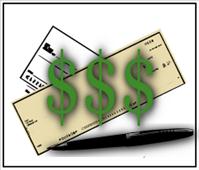|
Digital News Report – You may have noticed that those free checking accounts are disappearing and banks are charging more fees than they have in the past. The fees have increased or they have limited the amount of transactions you are allowed for free before paying. According to a Pew Charitable Trust study of the 10 largest banks, profits associated with overdraft penalty fees at banks have increased almost $20 billion over the last decade. The organization has a goal of making checking accounts offered by banks to have better transparency, fairness, responsibility, and free market principles.
The Pew study is called ‘Hidden Risks: The Case for Safe and Transparent Checking Accounts‘. They investigated the costs of overdraft penalty fees and other checking account fees that have been increased over the years. In 2000 the overdraft penalty fees for checking accounts were $18.6 billion and they have increased to $38.5 billion in fees for 2011. The typical overdraft fees would equate to an APR of 5,000 Percent said the report. While the Pew study recognizes that banks can risk losing money with checking account overdrafts, they also see that the banks don’t make it clear and easy for an account-holders to know what the risks are involved with these fees.
The data was collected in October of 2010 by the Pew researchers. They said that at that time of the data collection, all 100 percent of the 250 different types of checking account offered by the 10 largest banks that they had studied had set banks right to re-order withdrawals from the highest to lowest amount. That means that if you overdraft, the banks want to have multiple overdraft fees hopefully on several small amounts, versus clearing all the small amounts first and them just having the big amount with the overdraft fee.
In addition to this 8 out of 10 of the banks that they studied reserved the right to post withdrawals before deposits, increasing the likelihood of occurring overdraft fees. However, Pew stated the several of the lenders have changed their practices, but they said that some banks still do these tactics. The median average overdraft penalty fee was $35 said the study. In 2007, the average fee was $27. The FDIC says the median overdraft transaction was only $36.
The study also found that banks didn’t offer adequate information of how much it costs regarding overdraft protection services when it was offered.
The study presented graphic showing the disturbing expenses incurred from the overdraft fees that they found. The median average amount that a customer can be charged each day is $140 in overdraft fees. The transaction that caused an overdraft fee on average was $36 said the FDIC. While banks only accept deposits five days a week, they accept withdraws seven days a week. There are 49 different fees that an average checking account can be charged. The legal disclosures are around 111 pages long on average Pew suggests a one page document.
Consumers should be aware of these overdraft fees and other checking account fees. Make sure that you are aware of any extra charges. ATM fees, deposit fees, and other fees that the bank may have for the checking account all can add up to high monthly banking fees. Shopping around for a low cost checking account may take some time, but it could save money to a consumer in the long run.
By Victoria Brown

